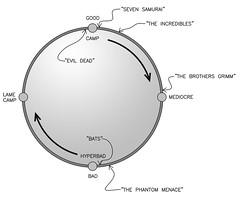Yet another weekend of buying too much good stuff from the farmers' market. It's tough to say no when everything looks1 so good. Sharon and I started to scramble to try to eat all the fresh produce possible before it spoils. As a brief listing of (some of) the spectacular bounty of summer, in alphabetical order:
- Apples. Ela Orchard was there, which seemed early to me. This being July. Bob assured us that he was actually a week or two later than usual, since he'd lost most of the first batch of Melbas.
- Artichokes. I wasn't aware that you could grow them in Wisconsin2, so they were a very pleasant surprise. Tory Miller'd already been by to scoop up the bulk of the crop, we were told, but there were still enough for a pre-dinner snack. It's been so long since I've had them that I decided to play it simple: trim, steam, salt, lime juice. (We were out of lemons, and had limes for fresh salsa.)
- Blackberries. Josh from Driftless Organics has the red scratches all over his hands and forearms to show for it. Small but intensely flavored, and enough to send Sharon wild. She's planning a blackberry pie, which she tells me is her childhood favorite.
- Blueberries. Dump a big pile into a bowl of yogurt and call it breakfast. Add a few currants, just for kicks.
- Cherries. Sweet ones this week, since we have a freezerful of sours. They didn't last beyond Sunday afternoon, and only that long because we were devouring blackberries and blueberries, too.
- Chillis. There were some habaneros, but only green ones. That can only mean one thing: a tradeoff of the floral aroma for an extra dose of crazy capsaicin heat. So we went with serranos, jalapenos and Peruvian ajis. I pureed some of them into a minty, walnutty pesto that was great on the grilled eggplant and corn, on the advice of Mark Bittman. (The Minimalist in the New York Times food section.) He suggested chilli powder, but if you've got fresh, use it.
- Corn. It's a sign of the American summer when the corn goes on the grill. Granted, most folks don't toss it on beside thick slices of eggplant, but that doesn't mean they shouldn't consider it. What didn't get the charcoal treatment is destined for fresh salsa.
- Currants. Because I can't get enough of them. We were too late3 for black, which I haven't had in years. Maybe next year.
- Green beans. Flat-type Romanos, to be precise, from JenEhr. I turned a few into a quick and spicy pickle, using dill seeds from the garden, and the rest'll get devoured before long. They've got a good bean flavor, keep crisp in the vinegar brine, and aren't tough or stringy. I can't believe I'd never dicovered them before.
- Pears. Ela Orchard again, with those little Grandma-something pears. I can't recall the name, but they're tiny and, as I recall from last year, not the best eating pear. I didn't bother to taste any this time, but went right ahead and poached them in sugar syrup with some fresh ginger. Bob also noted - with a big smile - that there are plenty of Moonglows on the trees this year. They might not get big, depending on the weather between now and harvest, but that's just fine. The smaller pears are just as delicious.
- Tomatoes. Sungolds, all brightness and sugar. A good selection of various colors from Tomato Mountain, even though I can't recall their names.4 And some green tomatoes from the Jacksons, on the elder Alice's recommendation. We split them two ways: half went into hobo packs on the grill, with onions and squash; the rest we breaded and fried. Though it isn't the healthiest choice ever, the fried green tomatoes were absolutely fantastic. I don't care if they're bad for me.
* * * * *
1And is.
2Okay, that's a lie. If Eliot Coleman can grow them in Maine, a dedicated and resourceful person ought to be able to do it in Wisconsin.
3In no small part because we bought so much before Blue Valley Gardens' stand that we had to haul back to the car to drop everything off.
4One was a Black Krim, I think, but I'm not entirely sure. Maybe a Brandywine, too. It's hard to say when you've picked out at least six different varieties.

